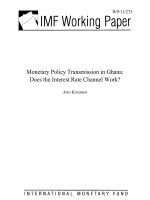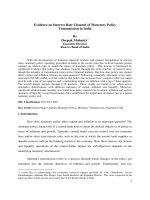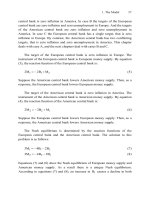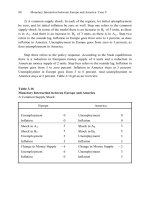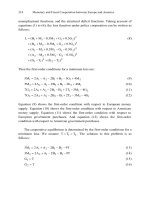Monetary policy strategies in the world economy carlberg_8 docx
Bạn đang xem bản rút gọn của tài liệu. Xem và tải ngay bản đầy đủ của tài liệu tại đây (1.4 MB, 31 trang )
218
unemployment functions, and the structural deficit functions. Taking account of
equations (1) to (6), the loss function under policy cooperation can be written as
follows:
2
11 21 2
2
22 12 1
2
11 21 2
2
22 12 1
22
11 2 2
L(B M 0.5M G 0.5G)
(B M 0.5M G 0.5G )
(A M 0.5M G 0.5G )
(A M 0.5M G 0.5G )
(G T ) (G T )
=+− ++
++− ++
+−+ −−
+−+ −−
+− + −
(8)
Then the first-order conditions for a minimum loss are:
112121 2
5M 2A A 2B B 3G 4M=−−+−+ (9)
2212121
5M 2A A 2B B 3G 4M=−−+−+ (10)
11212112
7G 2A A 2B B 2T 3M 4G=+−−+−− (11)
22121221
7G 2A A 2B B 2T 3M 4G=+−−+−− (12)
Equation (9) shows the first-order condition with respect to European money
supply. Equation (10) shows the first-order condition with respect to American
money supply. Equation (11) shows the first-order condition with respect to
European government purchases. And equation (12) shows the first-order
condition with respect to American government purchases.
The cooperative equilibrium is determined by the first-order conditions for a
minimum loss. We assume
12
TT T
=
= . The solution to this problem is as
follows:
11212
3M 2A A 2B B 9T=+−−− (13)
22121
3M 2A A 2B B 9T=+−−− (14)
1
GT= (15)
2
GT= (16)
Monetary and Fiscal Cooperation between Europe and America
219
Equations (13) to (16) show the cooperative equilibrium of European money
supply, American money supply, European government purchases, and American
government purchases. As a result there is a unique cooperative equilibrium. An
increase in
1
A causes an increase in European money supply, an increase in
American money supply, no change in European government purchases, and no
change in American government purchases. A unit increase in
1
A causes an
increase in European money supply of 0.67 units and an increase in American
money supply of 0.33 units.
As a result, monetary and fiscal cooperation can reduce the loss caused by
inflation, unemployment, and the structural deficit. Monetary and fiscal
cooperation is different from monetary and fiscal interaction. This applies to
cases A, B and C of monetary and fiscal interaction, see Part Seven. On the other
hand, monetary and fiscal cooperation is equivalent to pure monetary cooperation
of type B. And what is more, monetary and fiscal cooperation is equivalent to
pure monetary interaction of type B, see Part Three.
1. The Model
220
2. Some Numerical Examples
It proves useful to study eight distinct cases:
-
a demand shock in Europe
-
a supply shock in Europe
-
a mixed shock in Europe
-
another mixed shock in Europe
-
a common demand shock
-
a common supply shock
-
a common mixed shock
-
another common mixed shock.
1) A demand shock in Europe. In each of the regions, let initial
unemployment be zero, let initial inflation be zero, and let the initial structural
deficit be zero as well. Step one refers to a decline in the demand for European
goods. In terms of the model there is an increase in
1
A of 3 units and a decline in
1
B of equally 3 units. Step two refers to the outside lag. Unemployment in
Europe goes from zero to 3 percent. Unemployment in America stays at zero
percent. Inflation in Europe goes from zero to – 3 percent. Inflation in America
stays at zero percent. The structural deficit in Europe stays at zero percent, as
does the structural deficit in America.
Step three refers to the policy response. What is needed, according to the
model, is an increase in European money supply of 4 units, an increase in
American money supply of 2 units, no change in European government
purchases, and no change in American government purchases. Step four refers to
the outside lag. Unemployment in Europe goes from 3 to zero percent.
Unemployment in America stays at zero percent. Inflation in Europe goes from –
3 to zero percent. Inflation in America stays at zero percent. The structural deficit
in Europe stays at zero percent, as does the structural deficit in America. For a
synopsis see Table 7.19.
As a result, given a demand shock in Europe, monetary and fiscal
cooperation produces zero inflation, zero unemployment, and a zero structural
deficit in each of the regions. The loss function under policy cooperation is:
Monetary and Fiscal Cooperation between Europe and America
221
222222
121212
Luuss=π+π++++
(1)
The initial loss is zero. The demand shock in Europe causes a loss of 18 units.
Then policy cooperation brings the loss down to zero again.
Table 7.19
Monetary and Fiscal Cooperation between Europe and America
A Demand Shock in Europe
Europe America
Unemployment 0 Unemployment 0
Inflation 0 Inflation 0
Structural Deficit 0 Structural Deficit 0
Shock in A
1
3
Shock in B
1
− 3
Unemployment 3 Unemployment 0
Inflation
− 3
Inflation 0
Change in Money Supply 4 Change in Money Supply 2
Change in Govt Purchases 0 Change in Govt Purchases 0
Unemployment 0 Unemployment 0
Inflation 0 Inflation 0
Structural Deficit 0 Structural Deficit 0
2) A supply shock in Europe. In each of the regions let initial unemployment
be zero, let initial inflation be zero, and let the initial structural deficit be zero as
well. Step one refers to the supply shock in Europe. In terms of the model there is
an increase in
1
B of 3 units and an increase in
1
A of equally 3 units. Step two
refers to the outside lag. Inflation in Europe goes from zero to 3 percent. Inflation
in America stays at zero percent. Unemployment in Europe goes from zero to 3
percent. And unemployment in America stays at zero percent.
2. Some Numerical Examples
222
Step three refers to the policy response. What is needed, according to the
model, is no change in European money supply, no change in American money
supply, no change in European government purchases, and no change in
American government purchases. Step four refers to the outside lag. Inflation in
Europe stays at 3 percent. Inflation in America stays at zero percent.
Unemployment in Europe stays at 3 percent. Unemployment in America stays at
zero percent. The structural deficit in Europe stays at zero percent, as does the
structural deficit in America. For an overview see Table 7.20.
As a result, given a supply shock in Europe, monetary and fiscal cooperation
is ineffective. The initial loss is zero. The supply shock in Europe causes a loss of
18 units. Then policy cooperation keeps the loss at 18 units.
Table 7.20
Monetary and Fiscal Cooperation between Europe and America
A Supply Shock in Europe
Europe America
Unemployment 0 Unemployment 0
Inflation 0 Inflation 0
Structural Deficit 0 Structural Deficit 0
Shock in A
1
3
Shock in B
1
3
Unemployment 3 Unemployment 0
Inflation 3 Inflation 0
Change in Money Supply 0 Change in Money Supply 0
Change in Govt Purchases 0 Change in Govt Purchases 0
Unemployment 3 Unemployment 0
Inflation 3 Inflation 0
Structural Deficit 0 Structural Deficit 0
Monetary and Fiscal Cooperation between Europe and America
223
3) A mixed shock in Europe. In each of the regions, let initial unemployment
be zero, let initial inflation be zero, and let the initial structural deficit be zero as
well. Step one refers to the mixed shock in Europe. In terms of the model there is
an increase in
1
B of 6 units. Step two refers to the outside lag. Inflation in
Europe goes from zero to 6 percent. Inflation in America stays at zero percent.
Unemployment in Europe stays at zero percent, as does unemployment in
America.
Step three refers to the policy response. What is needed, according to the
model, is a reduction in European money supply of 4 units, a reduction in
American money supply of 2 units, no change in European government
purchases, and no change in American government purchases. Step four refers to
the outside lag. Inflation in Europe goes from 6 to 3 percent. Inflation in America
stays at zero percent. Unemployment in Europe goes from zero to 3 percent.
Unemployment in America stays at zero percent. The structural deficit in Europe
stays at zero percent, as does the structural deficit in America. Table 7.21
presents a synopsis.
First consider the effects on Europe. As a result, given a mixed shock in
Europe, monetary and fiscal cooperation lowers inflation in Europe. On the other
hand, it raises unemployment there. And what is more, it produces a zero
structural deficit. Second consider the effects on America. As a result, monetary
and fiscal cooperation produces zero inflation, zero unemployment, and a zero
structural deficit in America. The initial loss is zero. The mixed shock in Europe
causes a loss of 36 units. Then policy cooperation brings the loss down to 18
units.
2. Some Numerical Examples
224
Table 7.21
Monetary and Fiscal Cooperation between Europe and America
A Mixed Shock in Europe
Europe America
Unemployment 0 Unemployment 0
Inflation 0 Inflation 0
Structural Deficit 0 Structural Deficit 0
Shock in A
1
0
Shock in B
1
6
Unemployment 0 Unemployment 0
Inflation 6 Inflation 0
Change in Money Supply
− 4
Change in Money Supply
− 2
Change in Govt Purchases 0 Change in Govt Purchases 0
Unemployment 3 Unemployment 0
Inflation 3 Inflation 0
Structural Deficit 0 Structural Deficit 0
4) Another mixed shock in Europe. In each of the regions, let initial
unemployment be zero, let initial inflation be zero, and let the initial structural
deficit be zero as well. Step one refers to the mixed shock in Europe. In terms of
the model there is an increase in
1
A of 6 units. Step two refers to the outside lag.
Unemployment in Europe goes from zero to 6 percent. Unemployment in
America stays at zero percent. Inflation in Europe stays at zero percent, as does
inflation in America.
Step three refers to the policy response. What is needed, according to the
model, is an increase in European money supply of 4 units, an increase in
American money supply of 2 units, no change in European government
purchases, and no change in American government purchases. Step four refers to
the outside lag. Unemployment in Europe goes from 6 to 3 percent.
Monetary and Fiscal Cooperation between Europe and America
225
Unemployment in America stays at zero percent. Inflation in Europe goes from
zero to 3 percent. Inflation in America stays at zero percent. The structural deficit
in Europe stays at zero percent, as does the structural deficit in America. Table
7.22 gives an overview.
First consider the effects on Europe. As a result, given another mixed shock
in Europe, monetary and fiscal cooperation lowers unemployment in Europe. On
the other hand, it raises inflation there. And what is more, it produces a zero
structural deficit. Second consider the effects on America. As a result, monetary
and fiscal cooperation produces zero inflation, zero unemployment, and a zero
structural deficit in America. The initial loss is zero. The mixed shock in Europe
causes a loss of 36 units. Then policy cooperation brings the loss down to 18
units.
Table 7.22
Monetary and Fiscal Cooperation between Europe and America
Another Mixed Shock in Europe
Europe America
Unemployment 0 Unemployment 0
Inflation 0 Inflation 0
Structural Deficit 0 Structural Deficit 0
Shock in A
1
6
Shock in B
1
0
Unemployment 6 Unemployment 0
Inflation 0 Inflation 0
Change in Money Supply 4 Change in Money Supply 2
Change in Govt Purchases 0 Change in Govt Purchases 0
Unemployment 3 Unemployment 0
Inflation 3 Inflation 0
Structural Deficit 0 Structural Deficit 0
2. Some Numerical Examples
226
5) A common demand shock. In each of the regions, let initial unemployment
be zero, let initial inflation be zero, and let the initial structural deficit be zero as
well. Step one refers to a decline in the demand for European and American
goods. In terms of the model there is an increase in
1
A of 3 units, a decline in
1
B
of 3 units, an increase in
2
A of 3 units, and a decline in
2
B of 3 units. Step two
refers to the outside lag. Unemployment in Europe goes from zero to 3 percent,
as does unemployment in America. Inflation in Europe goes from zero to – 3
percent, as does inflation in America.
Step three refers to the policy response. What is needed, according to the
model, is an increase in European money supply of 6 units, an increase in
American money supply of 6 units, no change in European government
purchases, and no change in American government purchases. Step four refers to
the outside lag. Unemployment in Europe goes from 3 to zero percent, as does
unemployment in America. Inflation in Europe goes from – 3 to zero percent, as
does inflation in America. And the structural deficit in Europe stays at zero
percent, as does the structural deficit in America. For a synopsis see Table 7.23.
As a result, given a common demand shock, monetary and fiscal cooperation
achieves zero inflation, zero unemployment, and a zero structural deficit in each
of the regions. The initial loss is zero. The common demand shock causes a loss
of 36 units. Then policy cooperation brings the loss down to zero again.
Monetary and Fiscal Cooperation between Europe and America
227
Table 7.23
Monetary and Fiscal Cooperation between Europe and America
A Common Demand Shock
Europe America
Unemployment 0 Unemployment 0
Inflation 0 Inflation 0
Structural Deficit 0 Structural Deficit 0
Shock in A
1
3
Shock in A
2
3
Shock in B
1
− 3
Shock in B
2
− 3
Unemployment 3 Unemployment 3
Inflation
− 3
Inflation
− 3
Change in Money Supply 6 Change in Money Supply 6
Change in Govt Purchases 0 Change in Govt Purchases 0
Unemployment 0 Unemployment 0
Inflation 0 Inflation 0
Structural Deficit 0 Structural Deficit 0
6) A common supply shock. In each of the regions, let initial unemployment
be zero, let initial inflation be zero, and let the initial structural deficit be zero as
well. Step one refers to the common supply shock. In terms of the model there is
an increase in
1
B of 3 units, as there is in
1
A . And there is an increase in
2
B of
3 units, as there is in
2
A . Step two refers to the outside lag. Inflation in Europe
goes from zero to 3 percent, as does inflation in America. Unemployment in
Europe goes from zero to 3 percent, as does unemployment in America.
Step three refers to the policy response. What is needed, according to the
model, is no change in European money supply, no change in American money
supply, no change in European government purchases, and no change in
American government purchases. Step four refers to the outside lag. Inflation in
Europe stays at 3 percent, as does inflation in America. Unemployment in
2. Some Numerical Examples
228
Europe stays at 3 percent, as does unemployment in America. The structural
deficit in Europe stays at zero percent, as does the structural deficit in America.
For an overview see Table 7.24.
As a result, given a common supply shock, monetary and fiscal cooperation
is ineffective. The initial loss is zero. The common supply shock causes a loss of
36 units. Then policy cooperation keeps the loss at 36 units.
Table 7.24
Monetary and Fiscal Cooperation between Europe and America
A Common Supply Shock
Europe America
Unemployment 0 Unemployment 0
Inflation 0 Inflation 0
Structural Deficit 0 Structural Deficit 0
Shock in A
1
3
Shock in A
2
3
Shock in B
1
3
Shock in B
2
3
Unemployment 3 Unemployment 3
Inflation 3 Inflation 3
Change in Money Supply 0 Change in Money Supply 0
Change in Govt Purchases 0 Change in Govt Purchases 0
Unemployment 3 Unemployment 3
Inflation 3 Inflation 3
Structural Deficit 0 Structural Deficit 0
7) A common mixed shock. In each of the regions, let initial unemployment
be zero, let initial inflation be zero, and let the initial structural deficit be zero as
well. Step one refers to the common mixed shock. In terms of the model there is
an increase in
1
B of 6 units and an increase in
2
B of equally 6 units. Step two
Monetary and Fiscal Cooperation between Europe and America
229
refers to the outside lag. Inflation in Europe goes from zero to 6 percent, as does
inflation in America. Unemployment in Europe stays at zero percent, as does
unemployment in America.
Step three refers to the policy response. What is needed, according to the
model, is a reduction in European money supply of 6 units, a reduction in
American money supply of 6 units, no change in European government
purchases, and no change in American government purchases. Step four refers to
the outside lag. Inflation in Europe goes from 6 to 3 percent, as does inflation in
America. Unemployment in Europe goes from zero to 3 percent, as does
unemployment in America. The structural deficit in Europe stays at zero percent,
as does the structural deficit in America. Table 7.25 presents a synopsis.
Table 7.25
Monetary and Fiscal Cooperation between Europe and America
A Common Mixed Shock
Europe America
Unemployment 0 Unemployment 0
Inflation 0 Inflation 0
Structural Deficit 0 Structural Deficit 0
Shock in A
1
0
Shock in A
2
0
Shock in B
1
6
Shock in B
2
6
Unemployment 0 Unemployment 0
Inflation 6 Inflation 6
Change in Money Supply
− 6
Change in Money Supply
− 6
Change in Govt Purchases 0 Change in Govt Purchases 0
Unemployment 3 Unemployment 3
Inflation 3 Inflation 3
Structural Deficit 0 Structural Deficit 0
2. Some Numerical Examples
230
As a result, given a common mixed shock, monetary and fiscal cooperation
lowers inflation. On the other hand, it raises unemployment. And what is more, it
produces zero structural deficits. The initial loss is zero. The common mixed
shock causes a loss of 72 units. Then policy cooperation brings the loss down to
36 units.
8) Another common mixed shock. In each of the regions, let initial
unemployment be zero, let initial inflation be zero, and let the initial structural
deficit be zero as well. Step one refers to the common mixed shock. In terms of
the model there is an increase in
1
A of 6 units and an increase in
2
A of equally
6 units. Step two refers to the outside lag. Unemployment in Europe goes from
zero to 6 percent, as does unemployment in America. Inflation in Europe stays at
zero percent, as does inflation in America.
Step three refers to the policy response. What is needed, according to the
model, is an increase in European money supply of 6 units, an increase in
American money supply of 6 units, no change in European government
purchases, and no change in American government purchases. Step four refers to
the outside lag. Unemployment in Europe goes from 6 to 3 percent, as does
unemployment in America. Inflation in Europe goes from zero to 3 percent, as
does inflation in America. And the structural deficit in Europe stays at zero
percent, as does the structural deficit in America. Table 7.26 gives an overview.
As a result, given another common mixed shock, monetary and fiscal
cooperation lowers unemployment. On the other hand, it raises inflation. And
what is more, it produces zero structural deficits. The initial loss is zero. The
common mixed shock causes a loss of 72 units. Then policy cooperation brings
the loss down to 36 units.
Monetary and Fiscal Cooperation between Europe and America
231
Table 7.26
Monetary and Fiscal Cooperation between Europe and America
Another Common Mixed Shock
Europe America
Unemployment 0 Unemployment 0
Inflation 0 Inflation 0
Structural Deficit 0 Structural Deficit 0
Shock in A
1
6
Shock in A
2
6
Shock in B
1
0
Shock in B
2
0
Unemployment 6 Unemployment 6
Inflation 0 Inflation 0
Change in Money Supply 6 Change in Money Supply 6
Change in Govt Purchases 0 Change in Govt Purchases 0
Unemployment 3 Unemployment 3
Inflation 3 Inflation 3
Structural Deficit 0 Structural Deficit 0
9) Summary. Given a demand shock in Europe, policy cooperation achieves
zero inflation, zero unemployment, and a zero structural deficit in each of the
regions. Given a supply shock in Europe, policy cooperation is ineffective. Given
a mixed shock in Europe, policy cooperation lowers inflation in Europe. On the
other hand, it raises unemployment there. And what is more, it produces a zero
structural deficit. Given another type of mixed shock in Europe, policy
cooperation lowers unemployment in Europe. On the other hand, it raises
inflation there. And what is more, it produces a zero structural deficit.
10) Comparing policy cooperation with other regimes. First, monetary and
fiscal cooperation is equivalent to pure monetary cooperation of type B, see Part
Three. Second, monetary and fiscal cooperation is equivalent to pure monetary
2. Some Numerical Examples
232
interaction of type B, see Part Three. Third, monetary and fiscal cooperation is
superior to monetary and fiscal interaction of type B, see Part Seven.
Monetary and Fiscal Cooperation between Europe and America
233
Chapter 5
Cooperation within Regions,
Interaction between Regions
1) Introduction. The framework of analysis is as follows. There is policy
cooperation between the European central bank and the European government.
Similarly, there is policy cooperation between the American central bank and the
American government. On the other hand, there is policy interaction between
Europe and America. The targets of policy cooperation within Europe are zero
inflation, zero unemployment, and a zero structural deficit in Europe. The targets
of policy cooperation within America are zero inflation, zero unemployment, and
a zero structural deficit in America.
The model of unemployment, inflation, and the structural deficit can be
represented by a system of six equations:
111 21 2
uAM0.5MG0.5G=−+ −− (1)
222 12 1
uAM0.5MG0.5G=− + −− (2)
11 1 21 2
B M 0.5M G 0.5Gπ= + − + + (3)
22 2 12 1
B M 0.5M G 0.5Gπ= + − + + (4)
111
sGT=− (5)
222
sGT=− (6)
2) Policy cooperation within Europe. The policy makers are the European
within Europe are zero inflation, zero unemployment, and a zero structural deficit
in Europe. The instruments of policy cooperation within Europe are European
money supply and European government purchases. There are three targets but
only two instruments, so what is needed is a loss function. We assume that the
European central bank and the European government agree on a common loss
function:
M. Carlberg, Monetary and Fiscal Strategies in the World Economy, 233
central bank and the European government. The targets of policy cooperation
DOI 10.1007/978-3-642-10476-3_25, © Springer-Verlag Berlin Heidelberg 2010
234
222
1111
Lus=π + +
(7)
1
L is the loss caused by inflation, unemployment, and the structural deficit in
Europe. We assume equal weights in the loss function. The specific target of
policy cooperation within Europe is to minimize the loss, given the inflation
function, the unemployment function, and the structural deficit function. Taking
account of equations (1), (3) and (5), the loss function under policy cooperation
within Europe can be written as follows:
2
111 21 2
2
11 21 2
2
11
L(BM0.5MG0.5G)
(A M 0.5M G 0.5G )
(G T )
=+− ++
+−+ −−
+−
Then the first-order conditions for a minimum loss are:
111 12 2
2M A B 2G G M=−− −+ (9)
1111 1 22
3G A B T 2M M G=−+− + − (10)
Equation (9) shows the first-order condition with respect to European money
supply. And equation (10) shows the first-order condition with respect to
European government purchases.
The cooperative equilibrium in Europe is determined by the first-order
conditions for a minimum loss. The solution to this problem is as follows:
111 12 2
2M A B 2T G M=−− −+ (11)
11
GT= (12)
Equations (11) and (12) show the cooperative equilibrium of European money
supply and European government purchases. Equation (11) is the reaction
function of the European central bank. And equation (12) is the reaction function
of the European government.
3) Policy cooperation within America. The policy makers are the American
central bank and the American government. The targets of policy cooperation
(8)
Cooperation within Regions, Interaction between Regions
235
within America are zero inflation, zero unemployment, and a zero structural
deficit in America. The instruments of policy cooperation within America are
American money supply and American government purchases. There are three
targets but only two instruments, so what is needed is a loss function. We assume
that the American central bank and the American government agree on a
common loss function:
222
2222
Lus=π + +
(13)
2
L is the loss caused by inflation, unemployment, and the structural deficit in
America. We assume equal weights in the loss function. The specific target of
policy cooperation within America is to minimize the loss, given the inflation
function, the unemployment function, and the structural deficit function. Taking
account of equations (2), (4) and (6), the loss function under policy cooperation
within America can be written as follows:
2
222 12 1
2
22 12 1
2
22
L(BM0.5MG0.5G)
(A M 0.5M G 0.5G )
(G T )
=+− ++
+−+ −−
+−
Then the first-order conditions for a minimum loss are:
222 211
2M A B 2G G M=−− −+ (15)
2222 211
3G A B T 2M M G=−+− +− (16)
Equation (15) shows the first-order condition with respect to American money
supply. And equation (16) shows the first-order condition with respect to
American government purchases.
The cooperative equilibrium in America is determined by the first-order
conditions for a minimum loss. The solution to this problem is as follows:
222 211
2M A B 2T G M=−− −+ (17)
22
GT= (18)
(14)
Cooperation within Regions, Interaction between Regions
236
Equations (17) and (18) show the cooperative equilibrium of American money
supply and American government purchases. Equation (17) is the reaction
function of the American central bank. And equation (18) is the reaction function
of the American government.
4) Policy interaction between Europe and America. The Nash equilibrium is
determined by the reaction functions of the European central bank, the American
central bank, the European government, and the American government. We
assume
12
TT T==. The solution to this problem is as follows:
11212
3M 2A A 2B B 9T=+−−− (19)
22121
3M 2A A 2B B 9T=+−−− (20)
1
GT= (21)
2
GT= (22)
Equations (19) to (22) show the Nash equilibrium of European money supply,
American money supply, European government purchases, and American
government purchases. As a result there is a unique Nash equilibrium. An
increase in
1
A causes an increase in European money supply, an increase in
American money supply, no change in European government purchases, and no
change in American government purchases.
5) Comparing the system of cooperation and interaction with other types of
systems. First, the system of cooperation and interaction is equivalent to the
system of monetary and fiscal cooperation, see Part Seven. Second, the system of
cooperation and interaction is equivalent to the system of monetary cooperation
B, see Part Three. Third, the system of cooperation and interaction is equivalent
to the system of monetary interaction B, see Part Three.
Cooperation within Regions, Interaction between Regions
238
Synopsis
Table 8.1
Monetary Policies in Europe and America
Monetary Interaction
between Europe and America
Unique
Nash Equilibrium
Monetary Cooperation
between Europe and America
Unique
Solution
Cooperative Solution
Is Identical to
Nash Equilibrium
Table 8.2
Fiscal Policies in Europe and America
Presence of a Deficit Target
Fiscal Interaction
between Europe and America
Unique
Nash Equilibrium
Fiscal Cooperation
between Europe and America
Generally,
Cooperative Solution
Is Different from
Nash Equilibrium
Unique
Solution
238
239
Table 8.3
Monetary and Fiscal Policies in Europe and America
Absence of a Deficit Target
Monetary and Fiscal Interaction
between Europe and America
No
Nash Equilibrium
Monetary and Fiscal Cooperation
between Europe and America
Multiple
Solutions
Table 8.4
Monetary and Fiscal Policies in Europe and America
Presence of a Deficit Target
Monetary and Fiscal Interaction
between Europe and America
Unique
Nash Equilibrium
Monetary and Fiscal Cooperation
between Europe and America
Generally,
Cooperative Solution
Is Different from
Nash Equilibrium
Unique
Solution
Synopsis
241
Conclusion
1. Monetary Policies in Europe and America
1.1. Monetary Interaction between Europe and America:
Case A
1) The model. The world economy consists of two monetary regions, say
Europe and America. The monetary regions are the same size and have the same
behavioural functions. An increase in European money supply lowers European
unemployment. On the other hand, it raises European inflation. Correspondingly,
an increase in American money supply lowers American unemployment. On the
other hand, it raises American inflation. An essential point is that monetary
policy in Europe has spillover effects on America and vice versa. An increase in
European money supply raises American unemployment and lowers American
inflation. Similarly, an increase in American money supply raises European
unemployment and lowers European inflation.
In the numerical example, a unit increase in European money supply lowers
European unemployment by 1 percentage point. On the other hand, it raises
European inflation by 1 percentage point. And what is more, a unit increase in
European money supply raises American unemployment by 0.5 percentage
points and lowers American inflation by 0.5 percentage points. For instance, let
European unemployment be 2 percent, and let European inflation be 2 percent as
well. Further, let American unemployment be 2 percent, and let American
inflation be 2 percent as well. Now consider a unit increase in European money
supply. Then European unemployment goes from 2 to 1 percent. On the other
hand, European inflation goes from 2 to 3 percent. And what is more, American
unemployment goes from 2 to 2.5 percent, and American inflation goes from 2 to
1.5 percent.
The target of the European central bank is zero inflation in Europe. The
instrument of the European central bank is European money supply. From this
follows the reaction function of the European central bank. Suppose the
241
242
American central bank lowers American money supply. Then, as a response, the
European central bank lowers European money supply. The target of the
American central bank is zero inflation in America. The instrument of the
American central bank is American money supply. From this follows the reaction
function of the American central bank. Suppose the European central bank
lowers European money supply. Then, as a response, the American central bank
lowers American money supply.
The Nash equilibrium is determined by the reaction functions of the
European central bank and the American central bank. It yields the equilibrium
levels of European money supply and American money supply. As a result, given
a shock, monetary interaction produces zero inflation in Europe and America.
2) A demand shock in Europe. Let initial unemployment in Europe be 3
percent, and let initial unemployment in America be zero percent. Let initial
inflation in Europe be – 3 percent, and let initial inflation in America be zero
percent. Step one refers to the policy response. According to the Nash
equilibrium there is an increase in European money supply of 4 units and an
increase in American money supply of 2 units. Step two refers to the outside lag.
Unemployment in Europe goes from 3 to zero percent. Unemployment in
America stays at zero percent. Inflation in Europe goes from – 3 to zero percent.
And inflation in America stays at zero percent. Table 9.1 presents a synopsis. As
a result, given a demand shock in Europe, monetary interaction produces zero
inflation and zero unemployment in each of the regions.
3) A supply shock in Europe. Let initial inflation in Europe be 3 percent, and
let initial inflation in America be zero percent. Let initial unemployment in
Europe be 3 percent, and let initial unemployment in America be zero percent.
Step one refers to the policy response. According to the Nash equilibrium there is
a reduction in European money supply of 4 units and a reduction in American
money supply of 2 units. Step two refers to the outside lag. Inflation in Europe
goes from 3 to zero percent. Inflation in America stays at zero percent.
Unemployment in Europe goes from 3 to 6 percent. And unemployment in
America stays at zero percent. Table 9.2 gives an overview. First consider the
effects on Europe. As a result, given a supply shock in Europe, monetary
interaction produces zero inflation in Europe. However, as a side effect, it raises
Conclusion
243
unemployment there. Second consider the effects on America. As a result,
monetary interaction produces zero inflation and zero unemployment in America.
Table 9.1
Monetary Interaction between Europe and America
A Demand Shock in Europe
Europe America
Unemployment 3 Unemployment 0
Inflation
− 3
Inflation 0
Change in Money Supply 4 Change in Money Supply 2
Unemployment 0 Unemployment 0
Inflation 0 Inflation 0
Table 9.2
Monetary Interaction between Europe and America
A Supply Shock in Europe
Europe America
Unemployment 3 Unemployment 0
Inflation 3 Inflation 0
Change in Money Supply
− 4
Change in Money Supply
− 2
Unemployment 6 Unemployment 0
Inflation 0 Inflation 0
1. Monetary Policies in Europe and America
244
1.2. Monetary Interaction between Europe and America:
Case B
1) The model. The targets of the European central bank are zero inflation and
zero unemployment in Europe. The instrument of the European central bank is
European money supply. There are two targets but only one instrument, so what
is needed is a loss function. We assume that the European central bank has a
quadratic loss function. The amount of loss depends on inflation and
unemployment in Europe. The European central bank sets European money
supply so as to minimize its loss. From this follows the reaction function of the
European central bank.
The targets of the American central bank are zero inflation and zero
unemployment in America. The instrument of the American central bank is
American money supply. There are two targets but only one instrument, so what
is needed is a loss function. We assume that the American central bank has a
quadratic loss function. The amount of loss depends on inflation and
unemployment in America. The American central bank sets American money
supply so as to minimize its loss. From this follows the reaction function of the
American central bank.
The Nash equilibrium is determined by the reaction functions of the European
central bank and the American central bank. It yields the equilibrium levels of
European money supply and American money supply. As a rule, inflation in
Europe and America is not zero. And unemployment in Europe and America is
not zero either.
2) A demand shock in Europe. We assume equal weights in each of the loss
functions. Let initial unemployment in Europe be 3 percent, and let initial
unemployment in America be zero percent. Let initial inflation in Europe be – 3
percent, and let initial inflation in America be zero percent. Step one refers to the
policy response. According to the Nash equilibrium there is an increase in
European money supply of 4 units and an increase in American money supply of
2 units. Step two refers to the outside lag. Unemployment in Europe goes from 3
to zero percent. Unemployment in America stays at zero percent. Inflation in
Conclusion



